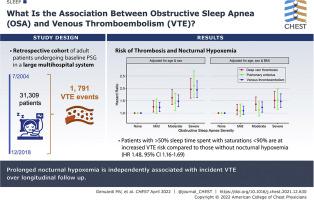Chest ( IF 9.5 ) Pub Date : 2021-12-13 , DOI: 10.1016/j.chest.2021.12.630 Michael V Genuardi 1 , Aman Rathore 2 , Rachel P Ogilvie 3 , Rebecca S DeSensi 2 , Priya V Borker 2 , Jared W Magnani 2 , Sanjay R Patel 2

|
Background
Previous studies suggesting that OSA may be an independent risk factor for VTE have been limited by reliance on administrative data and lack of adjustment for clinical variables, including obesity.
Research Question
Does OSA confer an independent risk of incident VTE among a large clinical cohort referred for sleep-disordered breathing evaluation?
Study Design and Methods
We analyzed the clinical outcomes of 31,309 patients undergoing overnight polysomnography within a large hospital system. We evaluated the association of OSA severity with incident VTE, using Cox proportional hazards modeling accounting for age, sex, BMI, and common comorbid conditions.
Results
Patients were of mean age 50.4 years, and 50.1% were female. There were 1,791 VTE events identified over a mean follow-up of 5.3 years. In age- and sex-adjusted analyses, each 10-event/h increase in the apnea-hypopnea index was associated with a 4% increase in incident VTE risk (hazard ratio [HR], 1.04; 95% CI, 1.02-1.06). After adjusting for BMI, this association disappeared (HR, 1.01; 95% CI, 0.99-1.03). In contrast, nocturnal hypoxemia had an independent association with incident VTE. Patients with > 50% sleep time spent with oxyhemoglobin saturation < 90% are at 48% increased VTE risk compared with those without nocturnal hypoxemia (HR, 1.48; 95% CI, 1.16-1.69).
Interpretation
In this large cohort, we found that patients with more severe OSA as measured by the apnea-hypopnea index are more likely to have incident VTE. Adjusted analyses suggest that this association is explained on the basis of confounding by obesity. However, severe nocturnal hypoxemia may be a mechanism by which OSA heightens VTE risk.
中文翻译:

OSA 患者的 VTE 发生率
背景
先前的研究表明 OSA 可能是 VTE 的独立危险因素,但由于依赖管理数据和缺乏对临床变量(包括肥胖)的调整,因此受到限制。
研究问题
OSA 是否会在转诊进行睡眠呼吸障碍评估的大型临床队列中赋予发生 VTE 的独立风险?
研究设计和方法
我们分析了 31,309 名在大型医院系统内接受过夜多导睡眠监测的患者的临床结果。我们使用考虑年龄、性别、BMI 和常见合并症的 Cox 比例风险模型评估了 OSA 严重程度与 VTE 事件的关联。
结果
患者平均年龄 50.4 岁,50.1% 为女性。在平均 5.3 年的随访期间,确定了 1,791 起 VTE 事件。在年龄和性别调整后的分析中,呼吸暂停-低通气指数每增加 10 次/小时,VTE 风险增加 4%(风险比 [HR],1.04;95% CI,1.02-1.06) . 调整 BMI 后,这种关联消失了(HR,1.01;95% CI,0.99-1.03)。相反,夜间低氧血症与静脉血栓栓塞事件独立相关。与没有夜间低氧血症的患者相比,睡眠时间 > 50% 且氧合血红蛋白饱和度 < 90% 的患者 VTE 风险增加 48%(HR,1.48;95% CI,1.16-1.69)。
解释
在这个大型队列中,我们发现根据呼吸暂停低通气指数测量的 OSA 更严重的患者更有可能发生静脉血栓栓塞事件。调整后的分析表明,这种关联是在肥胖混杂的基础上解释的。然而,严重的夜间低氧血症可能是 OSA 增加 VTE 风险的一种机制。











































 京公网安备 11010802027423号
京公网安备 11010802027423号